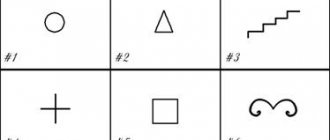Correctional work is great work for a child. The Federal State Educational Standard for Preschool Education indicates the need to “create favorable conditions for the development of children in accordance with their age and individual characteristics” and aims at ensuring that the child can freely “use speech to express his thoughts, feelings and desires...”.
To achieve this target in preschoolers with speech disorders, it is necessary to maintain interest in classes, relieve emotional and muscular tension that arises during correctional work, find new effective means, thereby reducing the time required for the stages of correctional intervention and directing efforts to activate independent speech. Therefore, for the successful correction of speech and motor skills in children, I decided to use sand in my work.
Sand therapy is one of the types of play therapy. And as you know, the main activity of a preschooler is play. In it he gets to know himself and the world around him. Playing in the sand is one of the natural activities of a child.
Kinetic sand is an innovative material for creativity and games, educational and cognitive processes.
Transferring traditional pedagogical classes to the sandbox gives a greater educational effect than standard forms of training.
Speech therapists know how long and monotonous the process of automating sounds can be; using sand to work on speech correction turns monotonous classes into an exciting process.
Kinetic sand was created in 2013. The sand consists of 98% pure sand and 2% silicone polymer. At first glance, it resembles wet sea sand, but as soon as you take it in your hands, its unusual properties appear. Polymer materials and quartz provide the viscosity necessary for modeling; it is plastic - on the one hand, and “fluid” on the other. You touch it, the sand “moves”, “comes to life”, flows through your fingers and at the same time remains dry. It is loose, but you can build a variety of shapes from it, it is pleasant to the touch, and does not leave marks on your hands. Can be used as a relaxant.
Kinetic sand can be used on any surface.
Material spilled on the floor does not scatter into separate particles, but is stored in the form of a compact mass that is easy to collect and reuse.
Sand is absolutely harmless, has antibacterial properties, does not contain toxic substances and does not cause allergies, therefore it can be used with the smallest children, both at home and in kindergarten.
Kinetic sand is a fabulous material for working with a child.
To organize games with sand, you need plastic molds of various sizes and themes, dough molds, stacks or wooden spatulas, a large set of miniature objects and toys, which together symbolize the world around us and reflect work on lexical topics. In my work I use figures of characters from Kinder Surprises, Lego, as well as various pebbles, shells, buttons, and large beads.
Using kinetic sand, I solve the following problems:
- development of phonemic concepts;
- improving the grammatical structure of speech;
- automation of delivered sounds;
- literacy training;
- development of coherent speech;
- formation of the syllabic structure of speech;
- development of fine motor skills.
Along with this, it is known that sand absorbs negative mental energy and has a relaxing effect. Experience shows that the use of sand therapy allows even a complex child to open up, maintain a preschooler’s ability to work longer, and also increase interest in speech therapy classes.
Games with kinetic sand used in work:
"Sand figure"
The child draws figures in the sand, then decorates them with various objects: pebbles, shells, buttons, coins. Thus, we fix the names of geometric shapes. Just like figures, you can decorate anything: fingerprints, palm prints, toys, etc.
“Whose traces?”
“Traces of a bear” - the child presses forcefully onto the sand with his fists and palms. “Hare tracks” - the child hits the surface of the sand with his fingertips, moving in different directions (like a hare jumping). “Traces of a snake” - a child makes the surface of the sand wavy with his fingers.
"Guess a riddle".
The child guesses the riddle and looks for the answer-toy in the sand.
“What’s missing?”
The child buries toys in the sand and says what is missing. Thus, we consolidate the use of nouns in the genitive case, singular and plural.
"Game of cars."
A game on the use of prepositions in speech: to, between, for, before, because of. The child talks about the location of the car relative to others. (The red car is driving towards the green car. And the blue car is standing between the trees.)
“Choose your words.”
The child selects adjectives (attribute words) for the toys that he finds in the sand. For example, a fox is cunning, red, etc.
"Count it."
The child counts from 1 to 5 a toy that he finds in the sand. For example, one elephant, two elephants, three elephants, four elephants, five elephants.
We will look for animals and choose words for them. A hedgehog, a fox, a bear again... Try to count them.
By analogy, other speech games are carried out: “One-many”, “Name it affectionately”, “Come up with a riddle”, “Name it in one word”, “The fourth odd one”, etc.
“Who can name more?”
The child selects verbs (action words) and places a shell, a pebble, or a button for each word.
By analogy, other speech games are carried out: “Words-relatives”, “Name the vegetables (fruits)”, etc.
“Steps” - pronounce the syllables assigned by the speech therapist, “walking” them with your finger in the sand.
“Find toys” - the speech therapist buries toys with the sound L in the sand: a horse, a doll, a spoon, an elephant, so that the toy in the sand is indicated by a low mound. Then he invites the child to find toys and name them. Ask what sound is heard in all the words. Ask them to make a sentence with each toy.
"In search of treasure."
This fairy sand comes to our lesson. We love to sculpt, play and get toys.
Children look for pictures and objects in the sand. And they say: “I found a cat...”
"Girlfriends"
Sound differentiation game. Invite children to give gifts (toys, pictures) to two girlfriends: Masha - gifts with the sound [w], and Sonya - gifts with the sound [s]. Dig gifts out of the sand.
Games to differentiate other sounds are played in the same way.
“Hide your hands” - hide your hands in the sand after hearing a given sound.
“Sound pattern” Children lay out sound patterns from colored pebbles (blue, green, red) on the sand and perform sound-letter analysis of words.
“How many syllables?” The speech therapist (then the child) draws a given number of stripes on the sand, indicating syllables, and then comes up with a word based on their number.
With the help of various toys, children compose a fairy tale on the sand, retell it or dramatize it.
“Find the letters and name them.”
The speech therapist hides plastic letters in the sand. The child must find and name all the letters.
“Say the word.”
The child takes out the letter hidden by the speech therapist and names a word starting with this sound.
"Make a word."
The speech therapist hides plastic letters in the sand. The child must find, name all the letters and make a word from them.
In my work, I noted that the use of kinetic sand gives positive results. Children's interest in speech therapy classes increases significantly. They feel more successful. They want to replay even a failed exercise several times, eventually achieving the desired result.
Any teacher can use kinetic sand in their work when the issue of interacting with children who require special attention arises. This is relevant when organizing inclusive education.


